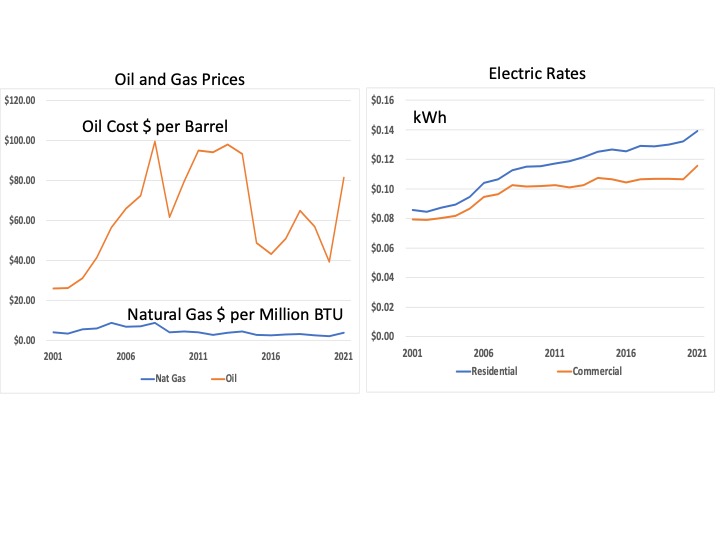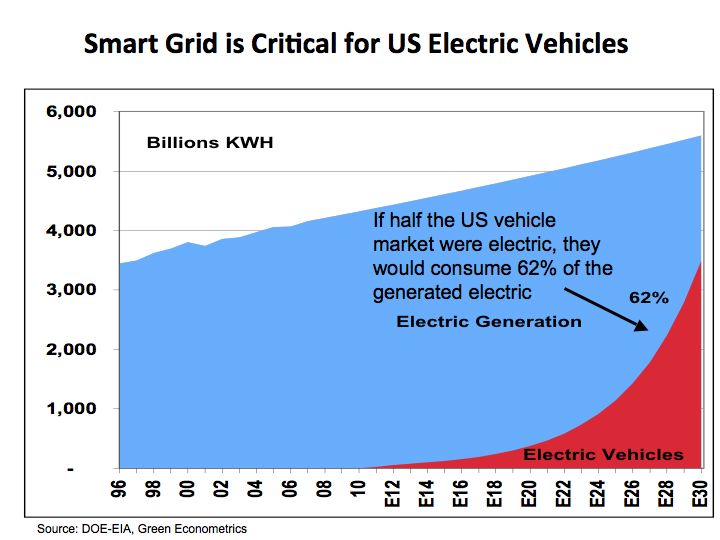Category Fuel Costs
Economics of Oil
Advances in technology such as seismic imaging with Dawson Geophysical and horizontal drilling with Schlumberger have dramatically changed the economics of oil and gas extraction. The change in oil economics is so profound that the cost structure of hydrocarbon fuels will reverberate through the global energy market and impact pricing of renewables energies and investment decisions. So profound are these changes that the US has surpassed Saudi Arabia and emerged as the world’s largest oil producer.
With the price of oil falling as a result of large production gains in US oil production. The price of oil is may fall below $40 per barrel according to an article in Barron’s The Case for $35 a barrel Oil suggesting further oil price declines are possible.
Infrastructure Investment: Electric Vehicles and Smart Grid
A Case for Natural Gas CHP Systems
A combined heat and power system (CHP) is the cogeneration or simultaneous generation of multiple forms of energy in an integrated system. CHP systems consume less fuel than separate heat and power generating systems. According to the Environmental Protection Agency in their Combined Heat and Power Partnership report, (EPA), CHP systems typically consume only three-quarters the amount of energy separate heat and power systems require. By combining both heat and power into the same energy systems, efficiency gains for the total system. Heuristically, high temperature and high pressure fuel ratios results in higher efficiency systems. In addition, the thermal energy produced from the CHP system could be used to drive motor applications or to produce heat, steam, and hot water.
As an initial step to reducing greenhouse gas (GHG) emissions, natural gas turbines could improve overhaul efficiency of 65-80%. In addition, the CHP offers lower greenhouse gas (GHG) emissions in comparison to conventional standalone systems. Gas turbines CHP systems operate under a homodynamic principle called the Brayton cycle. The design characteristics of a CHP gas turbine provide: 1) high electric and total system efficiency; 2) high temperature/quality thermal output for heating or for heat recovery steam power electric generation; 3) offer options for flexible fuels such as propane, natural gas, and landfill gas; 4) high reliability with 3-to-5 years before overhaul running 24/7; and 5) significantly lower GHG emissions.
Figure 1 Gas Turbine CHP System
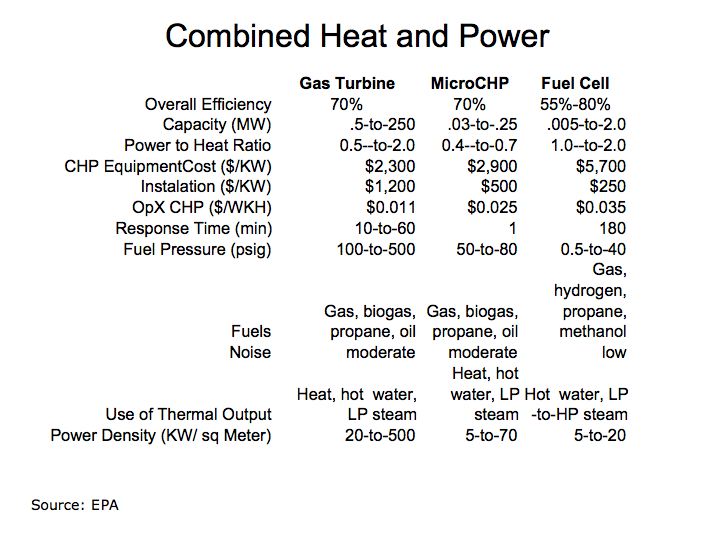
Figure 1 demonstrates the mechanics and variables of a CHP system. In summary, the CHP technology enables the supply of efficient heat and power while minimizing GHG emissions. Total CHP efficiency is defined as the sum of net power produced plus the thermal output used for heating divided by total fuel input.
The use of methane (natural gas) as the main fuel for the CHP system offers advantages because methane offers the highest hydrogen-to-carbon ratio among fossil fuels, thereby, combusting with the lowest GHG emissions. According to EPA data, the emissions NOx particulates from gas turbines ranges between 0.17-to-0.25 lbs/MWH with no post-combustion emissions control versus 1.0-to-4.2 lbs/MWH for coal fed boilers. The carbon content of natural gas is 34 lbs carbon/MMBtu in comparison to coal at 66 lbs of carbon/MMBtu.
There are two valuable metrics used to measure efficiency for CHP systems. One is the total system efficiency which measures the overall efficiency of the CHP system including heat and electric and the other is the effective electric efficiency which is useful in comparing the CHP electric production versus grid supplied power. These two metrics, the total system and effective electric efficiencies are important for evaluating CHP system. The following provides a guideline foe measuring these two efficiency metrics and can be found at EPA – Efficiency Metrics for CHP Systems
Figure 2 CHP Efficiency

The economics of the CHP system depends on effective use of thermal energy n the exhaust gases. Exhaust gases are primarily applied for heating the facility and could also be applied to heat recovery steam generators (HRSG) to produce additional electric power. The total efficiency of the CHP system is directly proportional to the amount of energy recovered from the thermal exhaust. Another important concept related to CHP efficiency is the power-to-heat ratio. The power-to-heat ratio indicates the proportion of power (electrical or mechanical energy) to heat energy (steam or hot water) produced in the CHP system. The following provides an overview of the economics of a CHP system.
Figure 3 CHP Economics
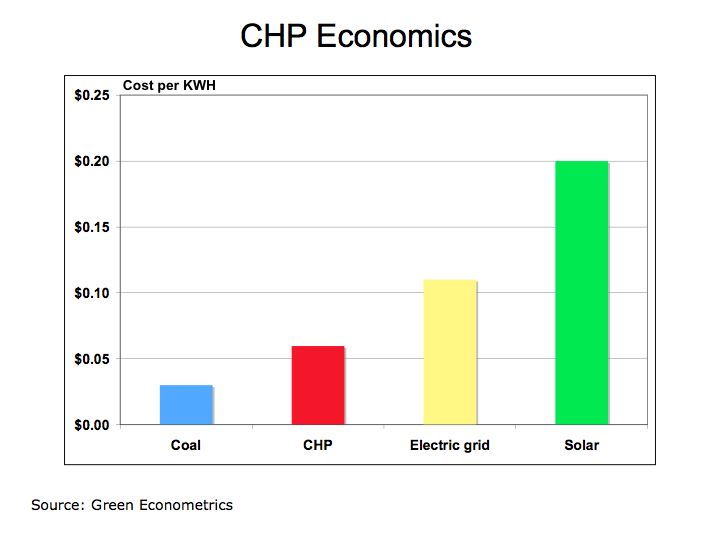
Figure 3 illustrates the economics of a CHP system in comparison to competing energy sources. While the CHP does not have the low cost of coal in producing electric, the economic value of reducing GHG emissions is quite significant and beyond the scope of this article. However, natural gas prices remain below that of oil and better ways of capturing heat exhaust will further improve CHP efficiency. The bottom line is that natural gas produces less GHG emissions than coal or oil therefore; businesses should consider the benefits of CHP as a source of heat and power.
Formulating an Effective Energy Efficiency Strategy with Measurement and Verification Copyright © 2009 Green Econometrics, LLC
The development of an energy efficiency strategy incorporates analysis of energy expenditures and energy consumption. The energy strategy must incorporate dynamics between costs, budgets and the consumption of energy including the monitoring of kilowatt-hours (KWH) of electricity and liquid hydrocarbon fuels consumed. By analyzing both the financial and the energy consumption components we are better positioned to frame the scope of the energy efficiency projects.
We start with a comprehensive energy audit analyzing energy consumption and expenditures. After determining which activities offer the fastest, cheapest, and greatest economic impact we are then able to define the scope of energy efficiency projects. The next step in the energy strategy process is to assess, rank and specify energy saving opportunities. At this phase, we have a broad understanding of the scope of energy efficiency projects within the appropriate budgetary considerations.
Conduct Energy Audit and Analyze Energy Spending
Upon analysis of the energy expenditures and the appropriate budgetary considerations, we commence with an energy audit to examine the dimensions of energy consumption. The energy audit establishes an energy efficiency baseline for buildings and vehicles. In the energy audit, energy consumption is measured by source and activity using monitors attached to branch circuits, gas pipes, and fuel lines. In this manner, energy consumption is evaluated from a financial and physical perspective and baseline usage patterns are established for electricity and other fuels.
During the energy audit, an analysis of energy intensity is measured. For buildings, energy consumption is measured in kilowatt-hours per square-foot to identify which activities consume the most energy. The energy intensity measurements are then ranked by consumption activity and compared to actual energy expenditures.
The purpose of the energy audit is to establish a baseline of energy consumption and the energy intensity associated with each building, department, vehicles, and/or activity usage category. By constructing an effective energy efficiency strategy that identifies and measures energy demand by activity, a better understanding of economic- and financial-impact is established. The critical component to the energy audit is measurement and verification were wireless Internet-based energy monitoring provide data before and after energy efficiency projects commence. The energy audit and energy monitoring systems together with financial analysis of energy consumption serve as the framework to rank and assess energy efficiency projects.
Heuristically, energy consumption in buildings is tied to lighting; and heating, cooling, and ventilation systems see Energy Intensity . The following chart, Figure 1 serves to illustrate which activities contribute most to energy consumption in buildings.
Figure 1 Kilowatt-hours (KWH) per Square Foot 
According to information provided by the DOE, lighting, cooling and ventilation alone account for nearly two-thirds of all energy consumption in a building. For perspective, electric energy demand is increasing at an annualized rate of 1.6%. According to the Energy Information Administration (EIA), demand for electricity grew 21% between 1995 and 2006.
The energy consumption audit provides a means to assess which activities should be further analyzed for energy efficiency projects. The baseline energy usage measured in KWH per square foot serves as the framework to evaluate that locations and activities could benefit from lighting retrofits, equipment upgrades, structural improvements, and energy monitoring systems.
As a consequence of increasing energy consumption in buildings, electric generation relies extensively on hydrocarbon fuels that carry adverse environmental effects. Figure 2 illustrates the proportion of coal and other hydrocarbon fuels that are used to generate electricity in comparison to renewable energy sources. Coal still accounts for nearly half of all electric generation while contributing the most in terms of harmful emissions such as carbon dioxide, nitrous oxide, and sulfur dioxide.
FIGURE 2: Electric Generation Method 
As part of the energy audit process for buildings, an energy consumption analysis of lighting and HVAC systems is evaluated along with the building’s insulation R-Value (resistance to heat flow where the higher the R-value, the greater the insulating effectiveness). In addition to lighting and HVAC systems, specialized equipment may also account for large energy demand. During our energy audit, we plan to identify and measure energy usage of special equipment in order to construct energy efficiency initiatives with clearly defined and measurable energy reduction targets.
Energy efficiency for transportation vehicles is one of the most significant factors to manage. The fact that there are no real substitutes for oil in the transportation industry illustrates two important points: 1) structural changes to driving patterns are required to see appreciable changes to oil consumption and 2) government authorities are vulnerable, with no readily available substitutes for oil, supply disruption could negatively impact transportation systems. Therefore, we emphasize fuel management systems for fleets and vehicles that monitor fuel consumption and efficiencies. DOE studies have indicated that changing driving habits could improve fuel efficiency by up to 30%.
Vehicle mounted devices that integrated fuel consumption feedback as the vehicle is driven promotes higher fuel efficiency. These off the shelf products are cost-effective, offering payback in months that dramatically improves fuel efficiencies. Aside from routine tune-ups, limiting weight, and checking tire pressure, augmenting driving patterns through gauges that provide feedback on fuel efficiency make the difference in saving energy.
In most situations, fuel management systems can be installed without significant mechanical aptitude. The ScanGaugeII from Linear-Logic is useable on most vehicles manufactured after 1996 including Gas, Diesel, Propane and Hybrid Vehicles and are designed to be installed by the consumer with plug-and-play instructions.
Identify and Measure Energy Demand by Activity
From the Energy Audit, the energy intensity of targeted buildings and fuel efficiencies of official vehicles are established. In buildings, it’s the lighting and heating, ventilation, and cooling that comprise the bulk of energy consumption.
Heating, ventilation, and cooling represent a significant portion of energy consumption in buildings and are a priority target for energy analysis. The Seasonal Energy Efficiency Ratio (SEER) is employed as an assessment of the equipment and analyzed in conjunction with building insulation. The efficiency of air conditioners is often rated in SEER ratio, which is defined by the Air Conditioning, Heating, and Refrigeration Institute and provides a standard unit measure of performance. The higher the SEER rating of a cooling system the more energy efficient the system is. The SEER rating is the amount of BTU (British Thermal Units) of cooling output divided by the total electric energy input in watt-hours.
For heating systems in a building, Annual Fuel Utilization Efficiency (AFUE) is used to measure and compare the performance of different systems. DOE studies have indicated that even with known AFUE efficiency ratings, heat losses defined as idle losses contribute to degradation in heating system efficiency,
To analyze energy consumption of heating and air conditioning systems (HVAC), we evaluate the building’s R-Value in comparison to the energy efficiency of the current heating and air conditioning systems. The energy demand evaluation includes a cost-benefit analysis comparing options in either HVAC system upgrade and/or improvements to the building’s insulation R-Value. By comparing the buildings R-Value in conjunction with HVAC efficiency performance, projects offering the greatest cost effectiveness are identified. The building’s R-Values can be measured using FLIR Systems infrared camera and software system. In this manner, the replacement cost of an HVAC system and costs to improve the building’s R-Value are analyzed to measure economic benefits. This information will allow the building owner to make an informed decision on whether any energy efficiency investment into HVAC upgrade or improvement to R-Value demonstrate economic benefit, i.e. positive financial return.
Consideration for heating and cooling systems upgrades are assessed by equipment SEER and AFUE ratings, installation costs, and efficiency payback. After equipment assessment is complete, proposals will be provided along with estimates for upgrade costs and payback analysis.
Benchmark and Analyze Energy Intensity
After conducting the energy audit, and compiling data on energy usage by activity category, we benchmark and analyze energy projects offering the greatest opportunities. As illustrated in Figure 3, energy efficiency for lighting systems can be substantially improved by retrofitting legacy light fixtures with higher efficiency fixtures and bulbs.
The energy audit and analysis provide the framework to evaluate energy efficiency projects. By analyzing energy consumption and the economic benefits associated with the energy savings projects, the most efficient and economically beneficial initiatives are identified and ranked.
FIGURE 3: Energy Savings in KWH per Square Foot Figure 1 Kilowatt-hours (KWH) per Square Foot 
Establish Measurable Goals and Objectives
To establish relevant goals and objectives we are evaluating projects that are adhering to the SMART goal approach: specific, measurable, attainable, realistic and timely. Energy efficiency gains are most pronounced with lighting retrofits and energy monitoring in buildings in buildings and energy monitoring in vehicles.
After conducting an energy audit, analyzing energy consumption activities and the economics of energy efficiency projects, realistic and achievable energy savings goals are defined. Key performance metrics for energy savings are defined for buildings and vehicles. Key performance indicators are established for each project. For example, KWHs saved are defined for lighting retrofit projects, efficiency improvements for HVAC system upgrades, R-Value improvements for building insulation, and MPG gains for vehicles.
For each energy savings project, timelines are established with clearly defined milestones. Energy projects are presented with costs; expected energy savings measured in energy and dollar units, cost benefit analysis, and timelines.
Architect the Deployment of Energy Monitoring Systems
One of the first energy initiatives to consider in any energy savings project is the installation of an energy monitoring system for vehicles and buildings. Energy monitoring systems demonstrate the fastest and most economical pathways to achieving energy savings.
Energy monitoring systems for motor vehicles also demonstrate positive economic returns and real energy savings. The $180 energy-monitoring device with 10% fuel efficiency gain achieves breakeven at 14,500 miles with gasoline costing $2.50 a gallon.
Evaluate Feasibility of Renewable Energy Projects
Renewable energy projects such as solar and wind energy systems are often costly with long payback periods. Without tax incentives and grants, renewable energy projects are unable to demonstrate positive financial returns. However, utility rates for electric are expected to increase, improving the case for renewable energy projects. To improve the viability of alternative energy projects, energy efficiency projects such as lighting retrofit serve to lower energy consumption and therefore enhance the feasibility of solar and wind energy projects.
Oil Consumption Impacted More by Price than Deteriorating Economic Conditions
The fall in oil consumption was most dramatic following the escalating price of crude oil to $145.16 per barrel on July 14, 2008 then at any other point over the last several years. Price elasticity, a key concept in Economics 101, which measures the impact of price change to changes in unit volume sold, is helpful in determining which products have readily available substitutes or which, like oil are inelastic with no real substitutes.
As illustrated by Benjamin Graham and David Dodd in their book Security Analysis, 1940 edition, during the 1930’s the economy had a dramatic impact on spending and consumption particularly on discretionary items such as travel. In one illustration, the change in demand was most pronounced in railroad revenues where tickets purchased for railroad travel, declined 51% from 1929 to 1993 as measured by gross receipts for the railroad industry. Over this same period, spending on the consumer staples (inelastic demand), such as electricity encountered a decline of only 9%.
While almost everyone would agree that the current economic climate is one of the most challenging since the 1930’s, a quick review of oil consumption over the last several years illustrates that demand has not significantly contracted, suggesting driving habits only changed when prices escalated to over $100 per barrel. Oil consumption dropped only 4.9% from January 2008 through January 2009.
Figure 1 Oil Consumption 
As seen from Figure 1, the sharp drop in oil consumption in September 2008 of 8.3% appears as an aberration when measured over the whole year. The fact there are no real substitutes for oil in the transportation industry illustrates two important points: 1) structural changes to driving patterns are required to see appreciable changes to oil consumption and 2) how vulnerable we are as a nation with no readily available substitutes for oil in the transportation systems.
Figure 2 Oil Demand in China and India 
With China and India undergoing significant structural changes as they rapidly migrate towards motor vehicles for transportation suggests the demand for oil should continue to grow relatively unabated. Until the price of oil climbs back over $100 per barrel, we will not see the structural changes necessary to develop alternatives to oil in the transportation market.
The bottom line: energy and in particular, oil has not experienced a dramatic drop in demand during 2008 suggesting driving patterns were influenced more by the price of oil then the struggling economy. We must begin to shift emphasis to alternative energies such as solar as well as hybrids and electric vehicles.
A Historical Perspective on Energy Prices and Economic Challenges
To understand current energy prices it may serve us to examine historical energy prices. Our theme is energy economics and specifically that energy prices follow the laws of supply and demand to set pricing.
There are some interesting perspectives on historical energy prices from several books including Security Analysis, 1940 edition by Benjamin Graham and David Dodd, The Great Wave, by David Hackett Fischer; and The Industrial Revolution in World History, by Peter Stearns. These books provide extensive data on pricing, industry revenues, and the framework that energy and technology serve in the economics of the industrial world.
Figure 1 Historical Energy Prices 
With the risk of oversimplification, our first figure shows there have been four distinct energy prices waves that have rippled through history. The scarcity of wood that was used for building homes, heating, and tools became increasing scarce as deforestation spread through Europe in the 1300s and followed again in the 1600’s. Coal prices rose rapidly with the War of 1812 and the Napoleonic Wars. Oil prices peaked in 1982 and to an all time high of $145.16 on July 14, 2008.
Figure 2 Medieval Wood Prices 
During the Medieval period in world history wood prices increased nearly threefold according to David Fischer in the The Great Wave. Wood prices rose with scarcity and peaked in 1320 as impact of the Bubonic Plague began to kill a quarter of Europe’s’ population. Twenty years from its peak in 1320, wood prices declined by 48% as the Bubonic Plague reduces the population and in turn, lowering the demand for wood.
Figure 3 Wood Prices 
Figure 3. Illustrates the rapid rise in the demand for wood as the growing world populations benefited advances in science and agriculture from the Renaissance period. Wood is used for just about everything and prices climb as more land is used for agriculture leading to deforestation exacerbating the wood shortage. As demand for wood increases, prices subsequently follow. By the end of the 1600’s, coal begins to substitute for wood as an energy alternative.
With advances in technology came improvements in coal mining and transportation that allowed coal to substitute for wood as an energy source. With the invention such as Thomas Newcomen’s steam, powered pump in 1712 that facilitated coal mining and James Watt’s steam engine in 1765 that lead to advances in transportation including railroads and machinery, coal grew in importance as an energy source. These advances in technology enabled greater supplies of coal to enter the market which lead to declines in energy prices.
Figure 4 Coal Prices 
We can gleam from Figure 4 that coal prices peaked in 1810-to-1815 coinciding with the War of 1812 and the Napoleonic Wars. The technological advances in mining and transportations fostered the development of an infrastructure to support the coal industry. The price of coal rose as wars ragging in Europe and the US, increased the demand for materials and supplies such as coal. However, as the wars came to an end, the abundant supplies of coal allowed prices to fall keeping energy prices low.
Oil entered the picture with the drilling of the first oil well in northwestern Pennsylvania in 1859 and the Internal Combustion Engine in 1860 that facilitated the development of the oil industry.
As oil emerged to become the dominant fuel of the 20th Century, it’s only recently that we face supply shortages. To better understand the dynamics of energy pricing in the face of changing demand, a review of spending on railroads and electricity may serve as a surrogate for discretionary and consumer stable spending patterns.
Figure 5 Industry Segment Revenues 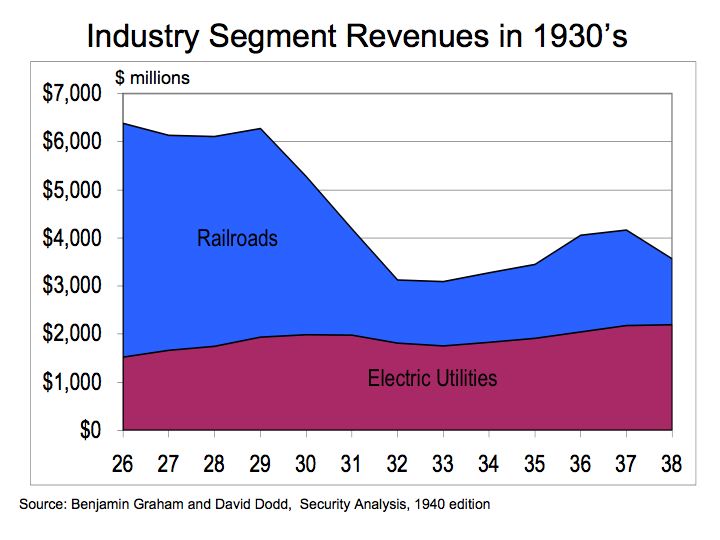
Figure 5 illustrates changes in the aggregate revenues of railroads in comparison to electric utilizes during the Great Depression. Copious notes taken by Graham and Dodd for their book Security Analysis help to demonstrate the economic laws of supply and demand.
The change in demand was most pronounced in railroad revenues. Expenditures on railroads, the more discretionary of the two industries, declined 51% from 1929 to 1993 as measured by gross receipts for the railroad industry. Over this same period, spending on the consumer stable, electricity only encountered a decline of 9%. In economic terms, railroads demonstrate greater demand elasticity meaning there is greater change in demand at prices change or this period, disposable income. While there is some discretionary portion of our spending associated with oil, a large portion of spending on oil is out of necessity. Therefore, even during times of great economic distress, the propensity for energy consumption is not eradicated entirely.
The bottom line: Energy pricing will continue to be dictated by supply and demand. Hydrocarbon fuels such as oil are finite in nature and therefore, without definitive strategies to cultivate alternative energy resources we will remain hostage to the vagaries in energy prices..
Don’t let the fall in Oil Prices Lead to Energy Complacency
The precipitous drop in oil prices may not hold for long. Speculators and fears of oil flow disruptions drove oil prices to an all time high of $145.16 on July 14, 2008 and is now down to $49.50 in November 20, 2008. Now the fear has shifted to the economy where deteriorating fundamentals suggest demand for oil will abate, at least in the near term. However, if history is any guide, demand for oil should be influenced by both structural changes such as consumers driving more fuel-efficient motor vehicles and cyclical factors such as the state of the economy.
Figure 1 US Historic Oil Imports 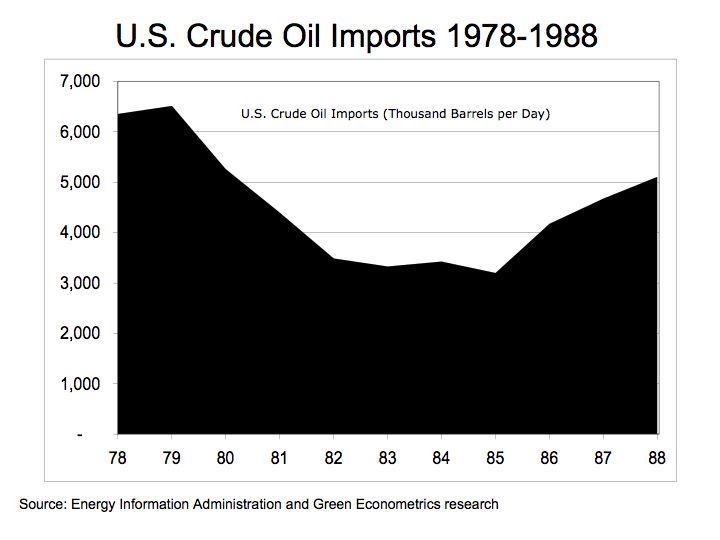
To get an understanding of the impact that both structural and economic factors had in reducing the demand for oil is to look at oil import from 1978 to 1988. Figure 1 illustrates the US demand for oil during the last major economic recession. The Oil Shock of the 1970’s severely impacted the US economy and the term stagflation captured our attention while interest rates reached exorbitant levels. From 1979 to 1982, US oil imports decline by 46% as the oil embargo of 1973 led to structural changes in oil consumption. US oil imports, as measured by the Energy Information Administration in U.S. Crude Oil Field Production (Thousand Barrels per Day) demonstrated a significant decline as a result of changing driving habits as fuel efficient import vehicles encroached on the domestic auto makers. The US consumers opted for foreign vehicles demonstrating higher fuel efficiencies and MPG entered our lexicon. These economic and structural changes dramatically reduced the demand for oil and subsequently, oil prices fell. It was not until 1985 before oil imports began to increase.
What’s missing from this analysis is the fact that during this period the US accounted for 27% of total world oil demand. . According to the Energy Information Administration (EIA), in 1980, China and India accounted for 2.8% and 1.0%, respectively, of the global demand for oil. In 1986, China and India increased their oil demand to account for 3.2% and 1.5% of the world market, respectively, an increase in oil demand of 57% for China and 44% for India.
In 2005, China and India account for 8.0% and 2.9% of global oil demand while US dropped to 24.9% of global oil demand. While even China and India are not immune to the current blissful economic environment, when the global economy does improve, their demand for oil will more than negate any structural changes the US consumers make in their driving habits. The demand for oil should continue to grow as an economic recovery ensues thereby leading to an increase in oil prices.
Figure 2 China and India Oil Consumption 
Figure 2. illustrates the rapid rise in the demand of oil from China and India. From 1980 to 2005, demand for oil increased 280% in China and 125% in India. Despite the improving fuel consumption in the US, the global oil market is more apt to be impacting from the growth in developing countries than conservation in the US.
The bottom line: don’t remain complacent, strive for energy efficiency and invest into alternative energies.
For further reading on oil prices please refer to
oil price analysis .
Vote the Economy by Voting for Energy
Access to energy was instrumental fueling the Industrial Revolution. Over the last 200 years, industrial nations have migrated from wood to coal and now to oil as a source of energy. During the 1700’s, wood was used for just about everything from fuel to constructing houses and building wagons and even tools. As demand for wood increased, the cost of wood rose as deforestation led to the scarcity. The scarcity of wood resulted in deteriorating economics.
It was the availability and access to coal that enabled the growth of Industrial Revolution by providing accessible energy. The Industrial Revolution was predicated upon the availability of Labor, Technology, Capital, and Energy. Scarcity of any of these inputs could undermine economic growth, as was the case with capital during the Great Depression of the 1930’s and the Energy Shock of the 1970’s.
Oil, driven by rapid growth in automobile usage in the U.S, has replaced coal as the main energy fuel. According to the Energy Information Administration (EIA), the 70% of oil consumption in the U.S. is for transportation .
Figure 1 US Oil Imports 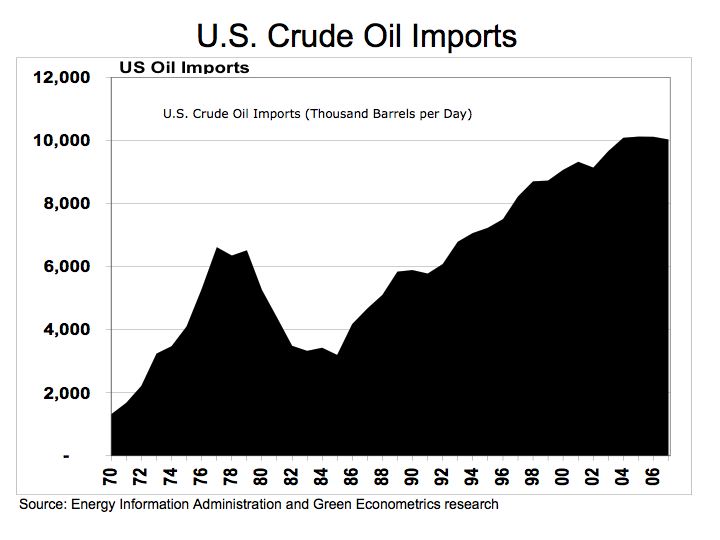
Figure 1 illustrates US historical oil imports, as measured by the Energy Information Administration in U.S. Crude Oil Field Production (Thousand Barrels per Day) that dates back to 1970. The EIA provides oil import data dating back to 1910. To estimate the amount of money the US spends on oil imports every year, we can use the data from the State of Alaska Department of Revenue, which provides historical data on the price of oil an derive an average yearly figure.
Figure 2 US Oil Import Spending 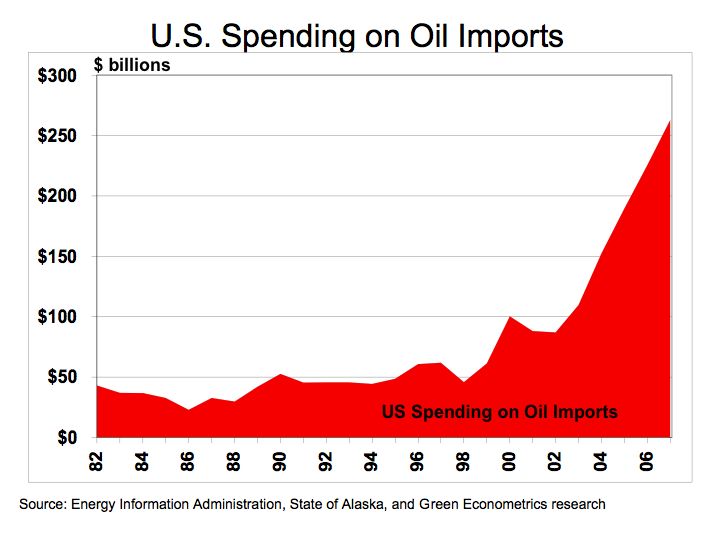
Figure 2. appears quite staggering given the amount of money we send to oil producing countries. The US is spending hundreds of billions to import oil. According to the EIA, the US imported an average of 10,031,000 barrels per day equating to $263 billion in imported oil during 2007 when the State of Alaska measured the yearly average spot price for a barrel of oil at $72.
According to Solarbuzz, Germany leads the world in solar photovoltaic (PV) installations with 47% of the market while China increased its market share of PV production from 20% to 35%. The US accounts for 8% of the world solar PV installations. Solarbuzz indicates the global solar PV industry was $17 billion in 2007 and the average cost of solar electricity is $0.2141 per KWH. If a portion of our $260 billion sent to oil producing countries were to be invested into solar energy, perhaps the US would not lag the world in alternative energy.
The bottom line is that the money spent on importing oil has a deleterious impact on our economy and continues our dependence on hydrocarbon fuels producing carbon and other harmful byproducts that negatively impact our climate and health of our children. The longer we are dependent on oil, the longer our economy and environment suffer. Use your vote for alternative energy and not drill baby drill.
Energy Crisis- Can we drill our way out?
Rising energy prices and our diminishing supply of oil threaten our national security. Without access to energy our economy and national defense are vulnerable to collapse. As a solution to our energy needs, we hear political rhetoric to expand oil drilling, but our energy strategy requires a long term solution that means embracing alternative/renewable energy technologies such as solar and wind. It only takes a quick review of oil production statistics to realize how formidable the challenge is that we face.
According to the Energy Information Administration (EIA) in 2007, the US consumed 20.6 million barrels of oil per day (bpd) but we were only able to produce 8.5 million bpd, leaving a deficit of approximately 12.2 million bpd. This means the US needs to import 60% of its oil and at a cost of $130 per barrel, the US will spend approximately $600 billion a year on imported oil.
Oil prices have increased dramatically with an increase of 420% since 2001. The combined impact of rising prices and diminishing oil production leaves the US in a precarious position. Yet, drilling for more oil may not rectify this tenuous situation.
As an example, back in the 1980’s, drilling activity in Alaska helped to ameliorate the oil crisis of the 1970’s. Today, oil production in Alaska has declined significantly. From its peak in 1988, oil production in Alaska has decline 64%. In Figure 1, oil production in Alaska in contrasted to the price of oil per barrel from 1980 to June 2008.
Figure 1 Alaska Oil Production

When we measure the supply and demand for oil, we find in the US, it is really a supply problem. According to the EIA , US demand for oil is growing at an annual rate of one percent over the last ten years, but oil production is down 20% since 1987.
Figure 2 US Oil Production
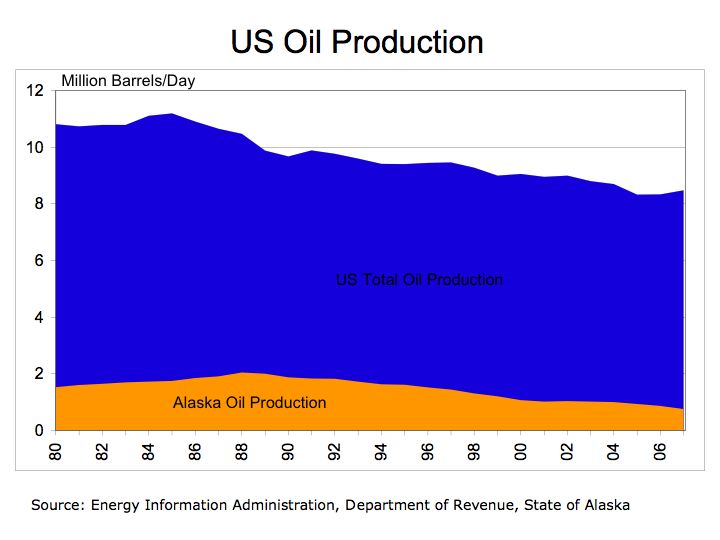
The energy problem however, is global. The demand for oil in the US may slow, yet supply constraints driven by growing consumption in developing countries could exacerbate this already bleak picture. On a per capita basis, the US consumes approximately 25 barrels of oil per person annually or a little over 600 gallons a year. That figure greatly exceeds other countries and particularly those in developing nations such as China.
In China, oil consumption per person is only 2 barrels or 84 gallons a year. However, oil consumption in China on a per capita basis has increased 88% from 1996 to 2006 according to data from the EIA. Despite China’s one percent population growth, at its current oil consumption growth rate, China is expected to double its current oil consumption by 2015 to over 14 million bpd and exceed the US in oil consumption by 2020. China’s current oil appetite suggests that in 14 years China will require an additional 14.6 million barrels per day. Even if oil producing countries are able to produce the additional oil, those countries that are unable to meet their own needs such as the US and China, will continue to be held hostage to oil producing states.
Figure 3 China Oil Consumption per Capita
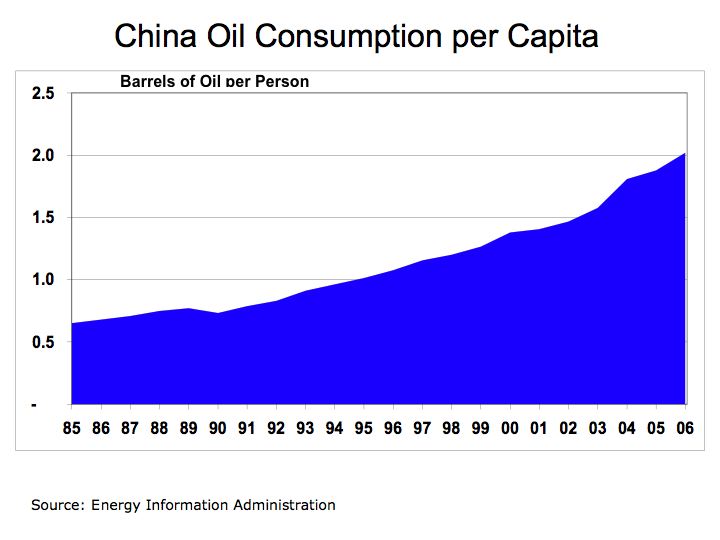
The bottom line: the energy model based on hydrocarbon fuels is broken. Neither drilling for more oil will not satisfy our energy needs nor will corn-based ethanol. We need to rapidly embrace electric vehicles using solar, wind, and fuel cell technologies to provide alternative energy solutions. It time to put energy as the most critical component of our national security. Energy should be front and center for the US election. It’s time to invest into clean and renewable energy solutions.
Energy Crisis – What Can We Do
As energy and food prices set new world records, what can we do at home to avert the crisis? Food prices are rising because corn is diverted from food production to producing ethanol for use as fuel in motor vehicles and is exacerbated by the recent flooding in the Mid West. Oil prices continue to escalate as demand for oil in developing countries increases and supply constraints, rising production costs, and limited refining capacity constrain the supply of oil. These factors continue to weigh against homeowners that will face escalating fuel bills to heat or cool their homes. There are some viable alternative energy solutions including wind and solar as well as home insulation that should offset the rising cost of energy. As far as food for fuel, we need to break our dependence on hydrocarbons which continues to impact our climate and weather and transfer our wealth to oil producing nations
Corn Prices have increased 264% since 2005. The rising price of corn used for ethanol is causing farmers to plant more corn and less production of other grains such as wheat or soy. Lower supply of grains is driving up food prices. Rising food prices is most debilitating to the poor, especially those in developing countries.
Figure 1 Corn Prices

Growing demand for oil and questions over Peak Oil suggesting even with oil prices rising to such an elevated level, production is rather anemic. According to the Energy Information Administration (EIA) , while oil prices increased 344% since 2001, oil production from OPEC is up only 1.2% over this same period.
Figure 2 Oil Prices

According to the EIA The demand for oil in China is growing at an 8.1% CAGR over the last five years. With demand for oil growing significantly in developing countries and despite production developments in Saudi Arabia and the 5-to-8 billion deepwater Tupi oil discovery in over Brazil The Tupi announcement in January 2008 is the world’s biggest oil find since a 12-billion-barrel field discovered in 2000 in Kazakhstan according the International Herald Tribune. These new oil discoveries are often in inhospitable areas or deep ocean environments, which makes extraction costly and difficult.
Figure 3 Rig Count and OPEC Oil Production

What can we do? . Forget drilling for more oil, electric vehicles and investment into alternative energy is the only way to avert this crisis. OPEC area drilling activity is up 48% since 1998 and yet, despite dramatically higher oil prices, up 5 fold since 1998, OPEC oil production increased only 11% over 1998.
Homeowners could begin to deploy energy saving and alternative energy systems. Wind and solar energy could help reduce some of the pain. As consumer embrace hybrids, electric, and fuel cell vehicles, wind and solar should begin to offer a stronger value proposition. Energy saving tips such as compact fluorescent bulbs, on-demand hot water heaters, and thicker home insulation products should help reduce heating and cooling costs.
According to the American Wind Energy Association AWEA a turbine owner should have at least a 10 mph average wind speed and be paying at least 10 cents per Kilowatt-hour (KWH) for electricity. There are electric utility and tax credits available in some areas. There are also questions regarding zoning restrictions, and whether to connect to batteries for energy storage, or directly to your electric utility. Consult the Wind Energy Resource Atlas of the United States Wind Resource Maps to get a better understanding of wind speeds in your area.
Cost wind systems will vary depending on model and installation costs will vary by your location. The Whisper 500 from Southwest Windpower offers electric production of 538 KWK/month at 12 mph (5.4 m/s). The system weighs 155 lb (70 kg) and has blade span of 15 feet (4.5 m) and must be mounted on a tower in cement. At 538 KWH per month, that is enough energy to cover the needs a modest house with conservative electric usage. Small wind systems can range from under $1,000 to over $20,000 with a payback period of approximately five years depending on wind resources and utility rates.
Solar photovoltaic (PV) panels cost an average of $4.80 per watt according to Solarbuzz which is about $0.24 per KWH over a 20 year life of the PV system. With an average output of approximately 10.6-watts/square foot (114 w/m^2), a five KW PV systems would cover 515 square feet (47.8 sq. meters) costing approximately $36,000 before credits and tax benefits and produce about 490 KWH per month. Of course installations costs are extra, but with PV production ramping and new PV suppliers entering the market we can expect costs to decline. Federal and local tax credits as well as selling unused electric to your local utility offers economic value on the margin.
The economic value is expected to increase as costs decline and electric rates increase and we can expect significantly higher utility rates in the near future. The economics of zero carbon emissions is not even measured as a benefit to the consumer. We are just beginning to see the cost impact of extreme weather and climate change.
Consumers should try to ameliorate the rising cost of energy by investing into solar and wind. There are several companies offering complete installation services. Among these include: Akeena Solar (AKNS) in California and The Solar Center in New Jersey.
The bottom line: energy and food prices are creating a crisis for consumers globally and there are several initiatives that could help minimize the pain. In addition, the erratic weather patterns around the world may be just a prelude to climate changes due to the impact of carbon dioxide on climate, which may cost us much more in the long run. Let’s stop the drain of wealth cause by oil and invest into clean and renewable energy solutions.
Blame high food and energy prices on the White House
With the infinite wisdom of the White House and U.S. Congress, food prices are now directly tied to the price oil. The price of corn-based ethanol is now determined by the price of gasoline that it substitutes in motor vehicles and that price is established by supply and demand for oil. The price of gasoline at your local gas station or convenience store is based on the price of oil. And now that the price of corn is rising because it is tied directly to oil, the price of other grains and subsequently, prices along the entire food chain are rising.
Corn Prices have increased 166% since 2005. The rising price of corn that is used to produce corn ethanol is causing farmers to direct their limited resources to grow more corn, which means other grains such as wheat or soy become scarce and their prices rise. The growing scarcity of grains for food products is raising price across the food chain. Developing a renewable energy solutions based on diverting food as a substitute for expensive gasoline forces food supplies to become scare and expensive.
It is the supply and demand for gasoline and diesel fuels that establishes the price at the pump. When corn ethanol is substituted for gasoline, prices tend to gravitate towards a mean price that continues to rise to keep pace with the escalating price of crude oil now over $110 per barrel. Corn prices are inextricably linked to oil prices and in turn; corn prices impact other grain prices that means it cost more to feed your family or to feed livestock and forces those prices higher.
The rise in corn prices is illustrated in Figure 1.
Figure 1 Corn Prices

Irrespective of the timing of Peak Oil, a long-term energy strategy is required. The days of cheap oil are over. Remember how oil production in Alaska helped ease the U.S demand for foreign oil a couple of decades ago. Oil production in Alaska declined by nearly 75 percent from its peak in 1987 according a Washington Post article back in 2005. In November 2007, the Petroleum News indicated production in Alaska is expected to decline further in the future. The U.S. depends on oil production in the Gulf of Mexico for about 25% of our supply, according to the Department of Energy which is why the impact from Hurricane Katrina was so devastating.
Diminishing supply and rising demand suggests oil prices should continue to remain elevated. The rising motor vehicle usage in China (China Motor Vehicle Registration)
and India continues to influence the demand for oil.
Figure 2 Vehicle Registrations in China

Figure 2 and Figure 3 illustrate the rising use of motor vehicles in developing countries. This trends should continue and in turn, increase the demand for oil.
Figure 3 Automobile Sales in India

Maybe we should look to some leading countries in the development of alternative energy strategies. Perhaps we can learn from Norway’s HyNor Project. Solar photovoltaic projects being lead by Germany
and Spain.
So the next time you fill your tank or when you’re at your local food store and find that your wages don’t quite cover your food bill, ask your local Congressional representative for better planning on alternative energy strategies and solutions. Investment and research into solar, wind, electric vehicles, and hydrogen energy could provide real solutions by addressing energy needs, climate concerns, the environment, and food prices.
The Economics of Energy – why wind, hydrogen fuel cells, and solar are an imperative
From the Industrial Revolution we learned that economic growth is inextricably linked to energy and as a result, our future is dependent upon equitable access to energy. When the Stourbridge Lion made entry as the first American steam locomotive in 1829 it was used to transport Anthracite coal mined in nearby Carbondale, PA to a canal in Honesdale that in turn linked to the Hudson River and onto New York City. Coal fueled the growth of New York and America’s Industrial Revolution because coal was cheap and more efficient than wood.
Advances in science and technology gave way to improvements in manufacturing, mining, and transportation. Energy became the catalyst to industrial growth. Steam power such as Thomas Newcomen’s steam powered pump in 1712 developed for coal mining and James Watt’s steam engine in 1765 were initially used to bring energy to market.
In terms of heating efficiency, coal at the time offered almost double the energy, pound for pound, in comparison to wood. Energy Units and Conversions KEEP Oil offers higher energy efficiencies over coal and wood, but as with most hydrocarbon fuels, carbon and other emissions are costly to our economy and environment.
With rapid growth in automobile production in the U.S., oil became the predominant form of fuel. According to the Energy Information Administration, in 2004 the U.S. spent over $468 billion on oil.
Figure 1 U.S. Energy Consumption by Fuel

We all need to become more conversant in understanding energy costs and efficiency and as a corollary, better understand the benefits of renewable energy such as solar, wind, and hydrogen fuel cells. A common metric we should understand is the kilowatt-hour (KWH) – the amount of electricity consumed per hour. The KWH is how we are billed by our local electric utility and can be used to compare costs and efficiency of hydrocarbon fuels and alternative energies.
One-kilowatt hour equals 3,413 British Thermal Units (BTUs). One ton of Bituminous Coal produces, on the average, 21.1 million BTUs, which equals 6,182 KWH of electric at a cost of about $48 per short ton (2,000 pounds). That means coal cost approximately $0.01 per KWH. To put that into perspective, a barrel of oil at $90/barrel distilled into $3.00 gallon gasoline is equivalent to 125,000 BTUs or 36.6 KWH of energy. Gasoline at $3.00/gallon equates to $0.08 per KWH. So gasoline at $3.00 per gallon is eight times more expensive than coal.
Is oil and gasoline significantly more efficient than coal? Let’s compare on a pound for pound basis. A pound of coal equates to about 10,500 BTUs or approximately 3.1 KWH per pound. A gallon of gasoline producing 125,000 BTUs weighs about 6 pounds equating to 6.1 KWH per pound (125,000 /3,413 /6). While gasoline is almost twice as efficient as coal, coal’s lower cost per KWH is why it is still used today to generate electric.
The Bottom Line: the economics of energy determines its use – coal still accounts for approximately half of our electric generation because it has a lower cost than other fuels. However, there are two factors to consider 1) the cost of carbon is not calculated into the full price of coal or other hydrocarbon fuels and 2) the cost of conventional fuel is calculated on a marginal basis while alternative fuel costs are calculated on a fixed cost basis. Meaning the cost of roads, trucks, and mining equipment is not factored into the price of each piece of coal, only the marginal cost of producing each ton of coal. For solar, hydrogen fuel cells, and wind energy systems, the cost to construct the system is factored into the total cost while the marginal cost of producing electric is virtually free. We need a framework to better measure the economics of alternative energy. The impact of carbon on our climate and global warming are clearly not measured in the costs of hydrocarbon fuels nor is the cost of protecting our access to oil such the cost the Iraq War.
Despite the carbon issues surrounding coal, (coal has higher carbon-to-hydrogen ratio in comparison to oil or gas) coal is more abundant and therefore is cheaper than oil. As electric utilities in 24 states embrace alternative energies through such programs as Renewable Portfolio Standards (RPS), perhaps the benefits of alternative energies will begin to combat the negative economics of hydrocarbon fuels.
Ethanol offers short-term solutions, but corn-based ethanol is not the answer
Ethanol may emit less CO2 and help reduce the demand for foreign oil in the short term, but ethanol and in particular, corn-based ethanol raises food prices, is less efficient than gasoline, diesel, and biodiesel, and is not a substitute for oil.
According to research compiled by National Geographic Magazine , the energy balance of corn ethanol, (the amount hydrocarbon fuel required to produce a unit of ethanol) is 1-to-1.3 whereas for sugar cane ethanol the ratio is 1-to-8. This suggests corn-based ethanol requires significantly more energy to produce than sugar cane ethanol. Corn ethanol is only marginally positive.
A major issue with corn ethanol is its impact on corn prices and subsequently, food prices in general. It is the price of oil that is impacting the price of corn because nearly all ethanol produced in the U.S. is derived from corn. Therefore, corn prices are inextricably linked to oil prices as well as to the supply and demand of corn as food and feedstock. Corn Prices while volatile and impacted from weather and other variables appear to follow the rising price of oil as illustrated in Figure 1. In turn, corn prices are also influencing other commodity prices where corn is used for feed for livestock.
The rising motor vehicle usage in China and India is escalating the already tenuous situation in the oil markets. With ethanol tied to oil prices we are beginning to see corn prices exacerbate the inflationary pressures at the retail level. Over the last year consumers are paying more for food with large increases in the prices of eggs, cereal poultry, pork, and beef which are tied to corn.
Figure 1 Corn Prices

Senate legislation for Renewable Fuels Standard calls for ethanol production to increase to 36 billion gallons by 2022 with 21 billion derived from as cellulosic material such as plant fiber and switchgrass . Corn is expected to comprise 42% of the ethanol production in 2002 from virtually all today. The fact is that ethanol production at its current level of 6 billion gallons equates to only 4% of our gasoline usage and is already impacting food prices. Gasoline consumption in 2005 amounted to 3.3 billion barrels or 140 billion gallons. Current estimates put gasoline consumption at 144 billion gallons a year in 2007. Even if vehicles could run entirely on ethanol, there is not enough corn harvest to substitute our demand for oil. We need a cohesive and coordinated effort using multiple technologies to develop alternative energies to reduce our dependence on foreign oil.
Performance
According to Renewable Fuels Association ETHANOL FACTS:
ENGINE PERFORMANCE, ethanol offers higher engine performance with octane rating of 113 in comparison to 87 for gasoline and has a long history in the racing circuit. In 2007, the Indy Racing League, sponsors of the Indianapolis 500 started using ethanol in racecars. However, the higher engine performance may come at a cost of lower fuel efficiency.
Table 1 Specific Energy, Energy Density & CO2
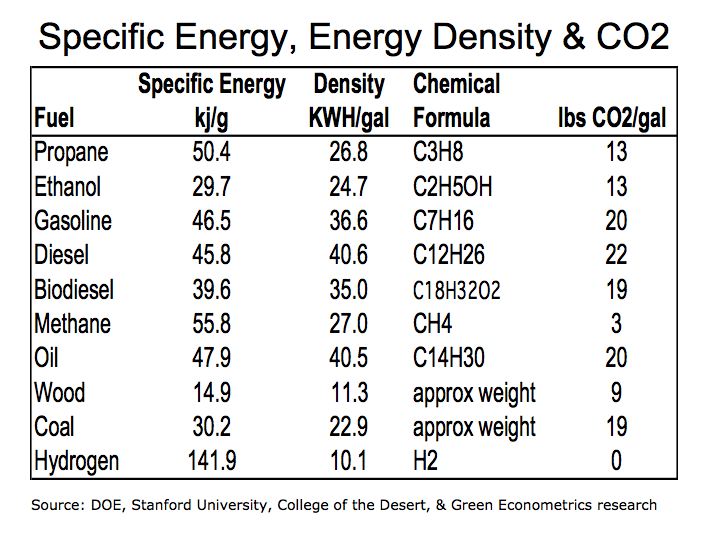
Efficiency
Gasoline offers 56% higher energy efficiency (specific energy) over ethanol as measured by kilo-joules per gram (kj/g). (As a reference: 1 kilowatt-hour = 3,600 kilojoules = 3,412 British Thermal Units) Biodiesel with 35 kj/g is 33% more energy efficient than ethanol at 24.7 kj/g.
In terms of energy density, ethanol would require larger storage capacity to meet the same energy output of gasoline diesel, and biodiesel. Ethanol requires a storage tank 48% larger than gasoline and 41% larger than diesel for the same energy output.
Please see Hydrogen Properties and Energy Units
For a quick review of Specific Energy and Energy Density – (Molecular Weight Calculator) the specific energy of a fuel relates the inherent energy of the fuel relative to its weight and is measured in kilo-joules per gram.
CO2 Emission
The molecular weight of CO2 is approximately 44 with two oxygen molecules with an approximately weight of 32 and one carbon atom with a weight of 12. During the combustion process, oxygen is taken from the atmosphere producing more CO2 then the actual weight of the fuel. In the combustion process a gallon of gasoline weighing a little over six pounds produces 22 pounds of CO2.
CO2 emission is a function of the carbon concentration in the fuel and the combustion process. During combustion ethanol produces approximately 13 pounds of CO2 per gallon. Gasoline and diesel produce approximately 22 and 20 pounds per gallon, respectively. CO2 emissions per gallon appear quite favorable for ethanol. However, the results are less dramatic when CO2 emissions are compared per unit of energy produced.
Figure 2 CO2 per KWH
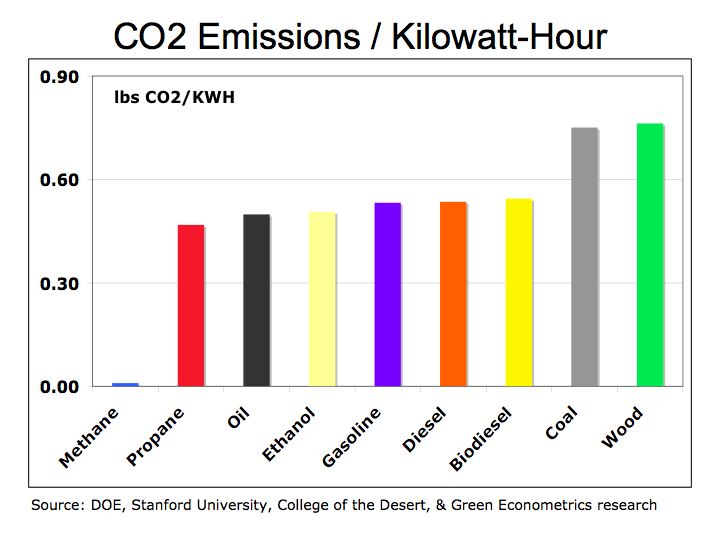
When measured in pounds of CO2 per kilowatt-hours (KWH) of energy, the results show ethanol producing 6% less CO2 than diesel or biodiesel and 5% less than gasoline. In the case of ethanol, the lower specific energy of the fuel negates the benefit of its lower CO2 emissions. Meaning more ethanol is consumed to travel the same distance as gasoline or diesel thereby limiting the benefit of its lower CO2 emissions.
The bottom line is ethanol does not ameliorate our dependence on foreign oil and while it demonstrates higher performance for racecars, it is still less efficient than gasoline diesel, and biodiesel, and diverts food production away from providing for people and livestock. The reality is there are special interest groups that obfuscate the facts about ethanol for their own benefit. The real solution to our imminent energy crisis is alternative energies including cellulosic ethanol, solar, hydrogen fuel cells, and wind.
The Importance of Energy to Economic Growth
A brief review of history and in particular the industrial Revolution, it’s quite apparent that economic growth is inextricably linked to energy. As energy is tied to our economy, our future is dependent upon equitable access to energy. This in turn sets the framework of our dependence on oil and hence, why our national security is tied to securing the flow of oil.
Eighteenth-Century England gave birth to the Industrial Revolution. Four critical components provided the framework enabling the Industrial Revolution: Labor, Technology, Risk Capital, and Energy
Improving efficiencies in agriculture lead to an increase in the food supply while minimizing the amount of labor required to cultivating crops. The improving agriculture efficiencies lead to population growth and an available labor force that began to migrate to the cities.
Advances in science and technology gave way to improvements in manufacturing, mining, and transportation. It was the harnessing of steam power such as Thomas Newcomen’s steam, powered pump in 1712 for coal mining and James Watt’s steam engine in 1765 that lead to railroads and machinery.
Risk capital was also an important element for the development of the Industrial Revolution. Risk capital and the entrepreneurial spirit that allowed capital to be applied innovation helped transition England into the largest economy in the world.
And Energy. Access to an available source of energy was instrumental fueling the Industrial Revolution. With wood being used for just about everything in the early 1700’s from housing, wagons, tools, and fuel, deforestation lead to energy scarcity. It was coal that enabled the growth of Industrial Revolution by providing an accessible energy source.
With rapid growth in automobile production in the U.S., oil became the predominant form of fuel. According to the Energy Information Administration, in 2004 the U.S. spent over $468 billion on oil. Given that we import nearly 60% of the oil we consume, most of our wealth travels abroad. More emphasis on alternative energies could help ameliorate our dependence on oil.
Figure 1 U.S. Energy Consumption by Fuel

While solar and wind energy have seen some very strong growth, alternative energy still account for less then 2% of our global energy production.
We need to realize that our dependence on oil could cripple our economy. Supply constraints or disruption to oil flow could derail economic activity. It should be an imperative for our national security to develop alternative energies.
Energy Shocks: Vulnerability Update
Rising oil prices have driven exploration and drilling activity, yet oil production remains anemic in comparison. Could the latest data suggest oil production is nearing a peak? With global demand expected to rise over 30% by 2030 according to a recent article in the Wall Street Journal, Handicapping the Environmental Gold Rush the latest oil production figures suggest we are indeed vulnerable to energy shocks.
High oil prices have driven demand for energy exploration and investment into oil and gas drilling rigs. In the U.S., rig count is up 181% with 1,749 rigs in operation in 2007 from 622 in 1999 according to Baker Hughes Worldwide Rig Count. Oil prices are up quite dramatically in the last few weeks with latest price above $94/barrel.
Figure 1 Worldwide Rig Count and Oil Prices
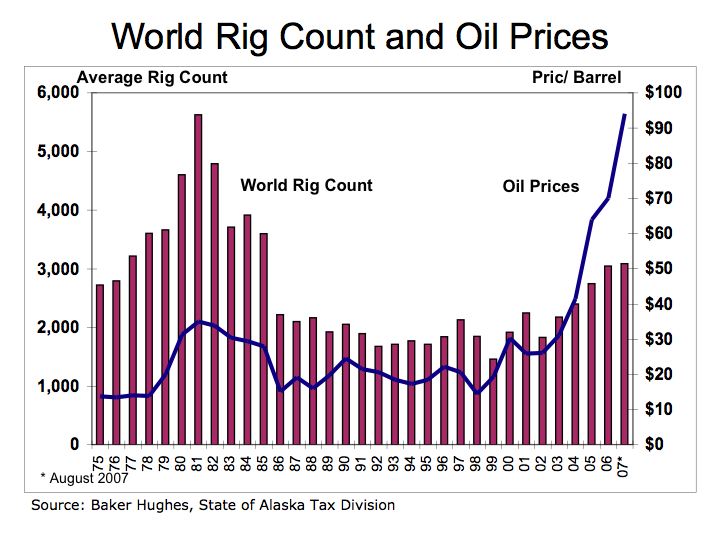
Figure 1 illustrates world-drilling rigs in comparison to oil prices. The U.S. accounts for over half the world oil drilling rigs yet our production is less than 10% of total global production. While oil prices are nearly as high as they were back in the 70’s (accounting for inflation) we are not witnessing the tremendous oil-drilling explosion as we did back then.
Part of the explanation could lie with oil production. If we look at recent data, oil production appears to be leveling off while demand is expected to increase significantly as developing countries increase their use of motor vehicles. Data from the U.S. Department of Energy (DOE) and Ward’s Communications, Ward’s World Motor Vehicle Data show that the number of motor vehicle on the road is up 48% from 1990 to 2005 with countries like China experiencing the most dramatic increase. Yet oil production over this same period is up only 27%.
Figure 2 US Rig Count and Oil Production
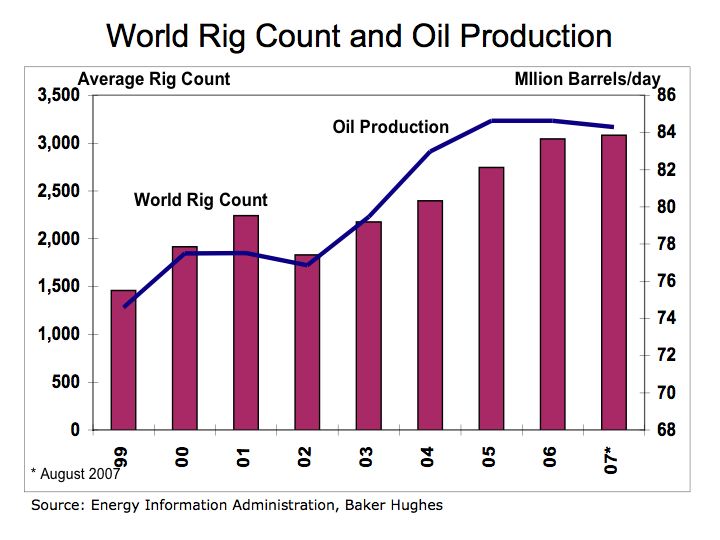
In the U.S., rig count is up 118% from 1999, yet petroleum production is actually down 7%. On a global basis, oil and petroleum product production increased 13% since 1999 while global rig count increased 112%. The U.S. and the rest of the world is experiencing diminishing returns on investments in oil production wile usage, led by motor vehicle consumption continues to escalate. In the U.S. more than 60% of oil consumption goes to vehicle use.
With all of the attention given to oil and hydrocarbon fuels, alternative energies are just a small fraction of our energy needs. We need to dramatically increase our research efforts into alternative energies such as solar, wind, and hydrogen fuel cells energies.
Solar and Hydrogen: Energy Economics
After reviewing some of the details of Honda’s experimental solar-power hydrogen refueling station in Torrance, CA and its fuel cell vehicle several questions concerning efficiency and practicality come to mind. It most be noted that solar and hydrogen don’t emit harmful byproducts such as carbon dioxide or carbon monoxide so both technologies are important to our energy security. First let’s look at the efficiency of hydrogen and second the efficiency of generating hydrogen from solar.
As we learned from science class, hydrogen is the most abundant element in the universe. Hydrogen has approximately 3 times the energy per unit mass as gasoline and requires about 4 times the storage volume for a given amount of energy according to a Hydrogen Energy report from Stanford University. In further review of additional information on hydrogen we are also making some adjustments to our fuel-ranking table.
We are revising Table 1 that was used in our post of October 3, 2007 for data on the energy density for hydrogen from 2.5 kilowatt-hours (KWH) per gallon to 10.1 KWH/gal and is reflected in the revised Table 1 below. The discrepancy lies in measuring the weight of hydrogen in liquid volume. We are calculating the energy density of hydrogen using the high heat values of hydrogen of 61,000 British Thermal Units (BTUs) and a weight 0.57 pounds per gallon from the Stanford Hydrogen Report.
As a reference: 1 KWH = 3,600 kilojoules = 3,412 BTUs
Revised Table 1 Specific Energy, Energy Density & CO2

Hydrogen offers tremendous energy potential, but as we see from Table 1, hydrogen has a low energy density meaning it requires a large storage container to make it practical for use in a motor vehicle. Several car manufacturers including GM and Toyota have developed hydrogen vehicles. Hydrogen can be used in internal combustion engines replacing gasoline or in fuel cells to generate electric to power the vehicle. However, there are some limitations to the current technology that may limit the economic viability hydrogen powered vehicles in the near term. But there are no detrimental emissions with hydrogen as apposed to hydrocarbon fuels thus providing tremendous benefits as vehicle efficiency improves.
Honda’s solar-powered hydrogen fueling station takes nearly a week in sun to produce enough hydrogen to power Honda’s FCX concept hydrogen fuel cell vehicle. Honda employs a Proton Exchange Membrane Fuel Cell (PEMFC) that converts hydrogen to electric that in turn, powers the vehicle. The Honda FCX fuel cell vehicle has two fuel tanks that can be filled with up to 156.6 liters of hydrogen or about 43 gallons that offers 430km (267 miles) driving range. The hydrogen fuel cell vehicle provides a reasonable driving range, but with a fuel efficiency of 6.5 miles per gallon (MPG), suggests more research is needed.
BMW’s Hydrogen 7 can travel 125 miles on hydrogen and 300 on gasoline before refueling. In tests the BMW 745h liquid-hydrogen test vehicle has 75 kg tank has a Hydrogen Fuel Efficiency of 10 km/liter or about 25.2 MPG and cruising speed of 110 MPH. Not too bad for an internal combustion engine that is able to run on gasoline or hydrogen.
Figure 1 Specific Energy
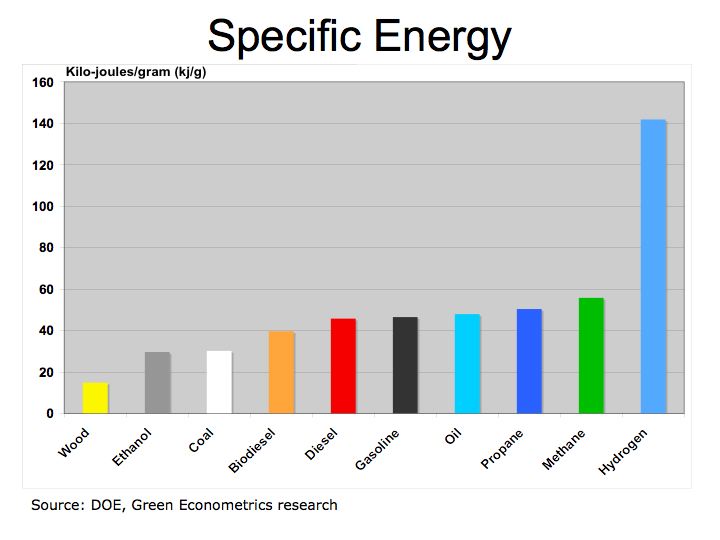
Given the changes to hydrogen’s energy density we are also adjusting hydrogen density (Figure 2) to reflect liquid hydrogen and high-energy value as noted by Hydrogen Properties College of the Desert.
Revised Figure 2 Energy Density: KWH per Gallon
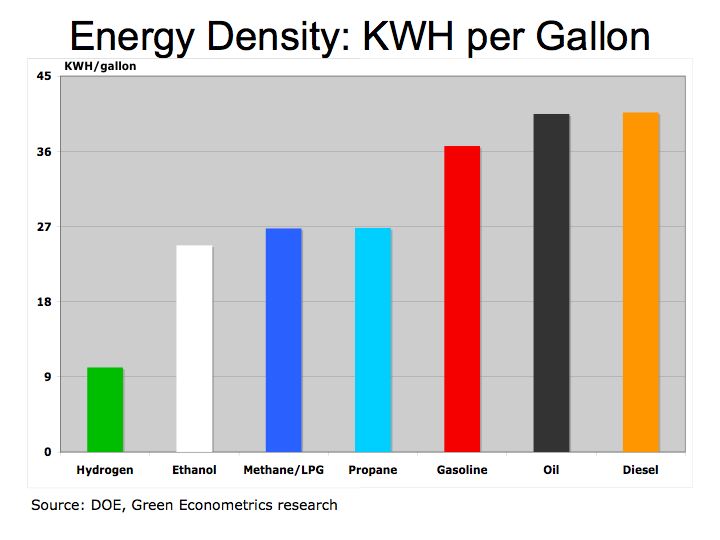
We still have more questions given hydrogen’s very high specific energy, (3 times that of gasoline) and low energy density (4 times the volume of gasoline). Hydrogen is more efficient then petroleum fuel, yet when used as a fuel cell in a vehicle Honda’s MPG of 6.5 MPG is quite low. The fuel efficiency of BMW’s Hydrogen 7 of 25.2 MPG is only at parity with gasoline.
The efficiency of using solar energy to generate hydrogen may not be the most efficient method. One report from Walt Pyle, Jim Healy, and Reynaldo Cortez Solar Hydrogen Production by Electrolysis indicated that a 1-kilowatt solar photovoltaic device could generate 1 cubic meter of hydrogen in 5.9 hours. Essentially, 5.9 KWHs from a 1KW solar cell produces 1 cubic meter of hydrogen. We know that a pound of hydrogen in liquid state equals approximately 61,000 BTUs (51,500 BTUs at low heat value) or 17.9 KWH.
Research at Caltech, suggests that photoelectrochemistry The Lewis Group may offer a more efficient means of generating hydrogen. We will continue to explore solar efficiency and hydrogen fuel cells to evaluate the economics of alternative energy.
The bottom line is that our dependence on foreign oil is the biggest threat to national security and without cultivation of alternative energies we continue to endure an untenable situation. Further research into solar and hydrogen fuel cells could significantly ameliorate our dependence on oil.
